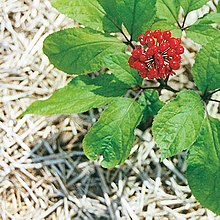Panax ginseng
| Panax ginseng | |
|---|---|

| |
| Scientific classification | |
| Kingdom: | |
| (unranked): | |
| (unranked): | |
| (unranked): | |
| Order: | |
| Family: | |
| Genus: | |
| Species: | Panax ginseng
|
| Synonyms | |
Panax ginseng, the ginseng,[2] also known as Asian ginseng,[2][3] Chinese ginseng,[2][3] or Korean ginseng,[2][3][4] is a species of plant whose root is the original source of ginseng. It is a perennial plant that grows in the mountains of Eastern Asia.
Names
Panax ginseng is called insam (인삼; 人蔘; lit. 'ginseng') in Korean, and gāolíshēn (高丽参; 高麗參; lit. 'Korean ginseng') in Chinese.
Distribution
Panax ginseng is native to mountainous regions of Russian Far East, Northeastern China, and the Korean Peninsula.[2] It is a protected plant in Russia and China, and most commercial ginseng is now sourced from plants cultivated in China, Korea and Russia. The plant is a slow-growing perennial and the roots are usually harvested when the plants are five or six years old.[5]
Cultivation
Panax ginseng is one of the most commonly cultivated ginseng species, along with P. notoginseng and P. quinquefolius.[6] All ginseng produced in South Korea is P. ginseng.[6]
See also
References
- ^ Synonyms in Catalogue of life
- ^ a b c d e "Panax ginseng". Germplasm Resources Information Network. Agricultural Research Service, United States Department of Agriculture. Retrieved 13 February 2018.
- ^ a b c "Asian Ginseng". National Center for Complementary and Integrative Health (NCCIH). September 2016. Retrieved June 24, 2017.
- ^ English Names for Korean Native Plants (PDF). Pocheon: Korea National Arboretum. 2015. p. 559. ISBN 978-89-97450-98-5. Archived from the original (PDF) on 25 May 2017. Retrieved 24 December 2016 – via Korea Forest Service.
{{cite book}}: Unknown parameter|deadurl=ignored (|url-status=suggested) (help) - ^ Mahady, Gail B.; Fong, Harry H.S.; Farnsworth, N.R. (2001). Botanical Dietary Supplements. CRC Press. pp. 207–215. ISBN 978-90-265-1855-3.
- ^ a b Baeg, In-Ho; So, Seung-Ho (2013). "The world ginseng market and the ginseng". Journal of Ginseng Research. 37 (1): 1–7. doi:10.5142/jgr.2013.37.1. PMID 23717152. Retrieved 11 August 2018.
